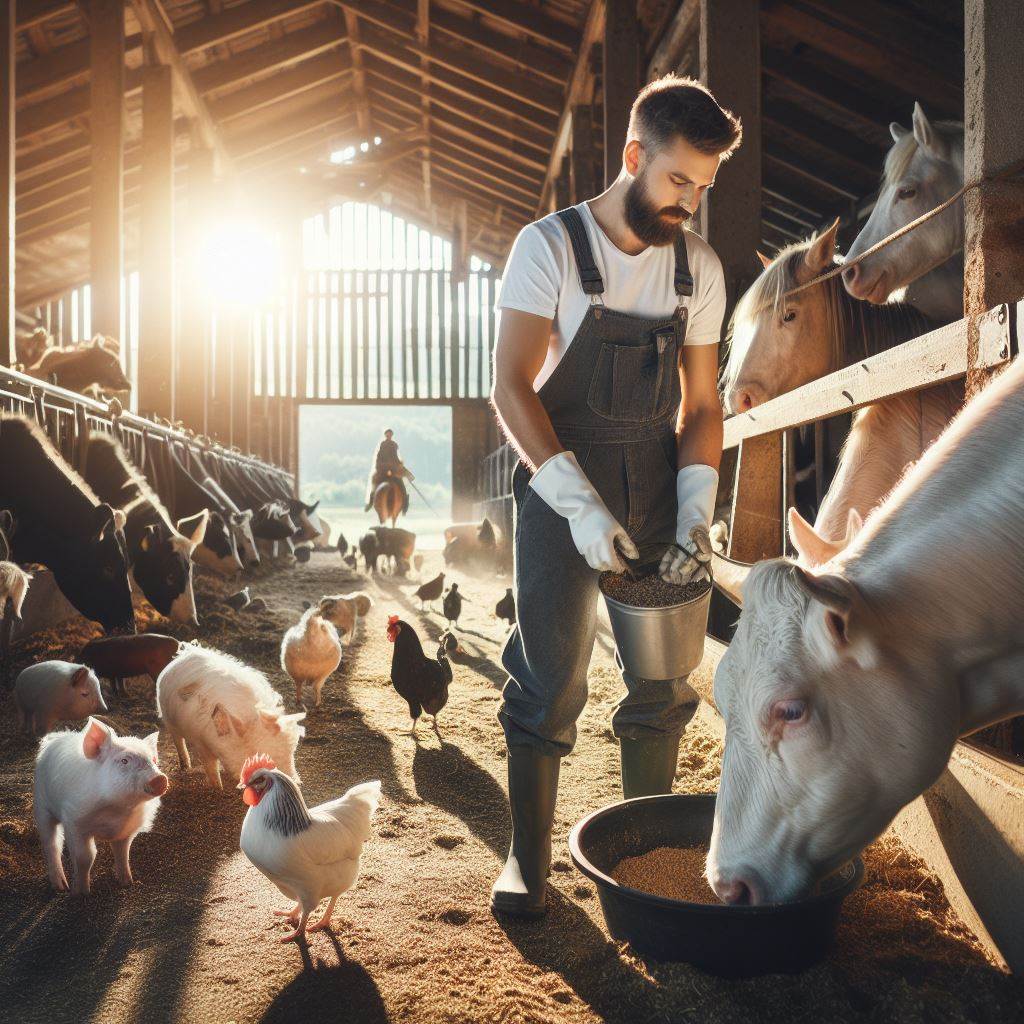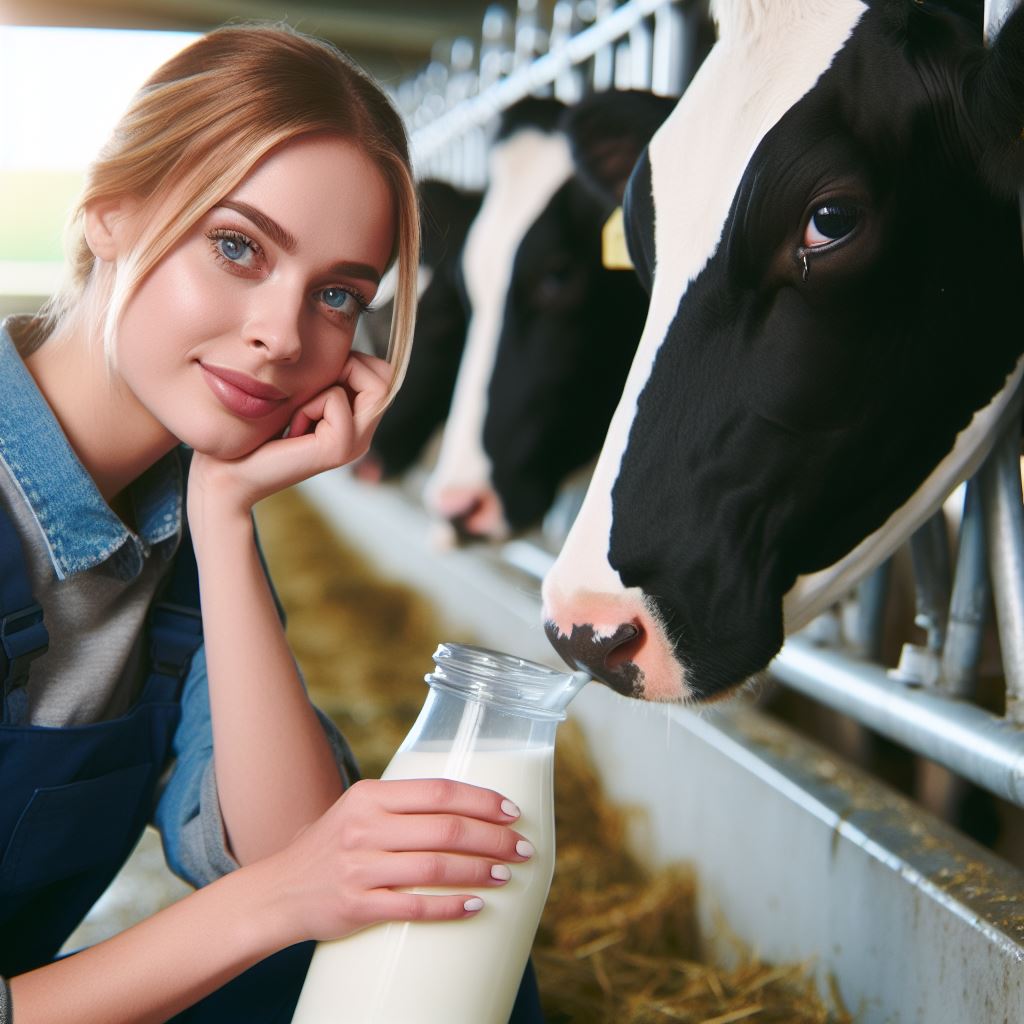Introduction
Feeding dairy cattle is of utmost importance in maintaining their overall health and productivity.
Proper feeding practices are key to ensuring that dairy cows have the necessary nutrients for milk production, reproductive success, and maintaining body condition.
This blog post will serve as a guide to help dairy farmers understand and implement the best practices for feeding their cattle.
The purpose of this blog post is to educate dairy farmers about the importance of proper feeding and provide them with practical tips and guidelines.
It will cover various aspects of dairy cattle feeding, including the types of feed, feeding schedules, and feeding management techniques.
By following these best practices, farmers can improve feed efficiency, minimize nutrient waste, and ultimately enhance the profitability of their dairy operations.
Through this blog post, dairy farmers will learn about the nutritional requirements of dairy cattle at different stages of production, such as lactation, dry period, and transition period.
They will also gain insights into the importance of balanced rations, proper feed storage, and feeding equipment maintenance.
Additionally, the blog post will discuss the importance of monitoring cow performance and making necessary adjustments to the feeding program based on individual needs.
In short, proper feeding practices are vital for the success of dairy cattle operations.
This blog post will equip dairy farmers with the knowledge and tools necessary to optimize the feeding management of their dairy cows, leading to improved milk production, overall herd health, and profitability.
Understanding the Nutritional Needs of Dairy Cattle
Feeding dairy cattle with a well-balanced and nutrient-rich diet is vital for their healthy growth and maximum milk production.
These animals require a combination of key nutrients to meet their specific needs.
Key nutrients required for healthy growth and milk production
- Carbohydrates: Carbohydrates serve as the primary source of energy for dairy cattle. They are converted into glucose, which is essential for bodily functions and milk production. Common sources of carbohydrates include grains, silage, and forages.
- Proteins: Proteins are crucial for muscle development, milk production, and repairing body tissues. Dairy cattle need high-quality protein sources like soybean meal or canola meal to meet their protein requirements. Amino acids, the building blocks of proteins, are essential for various metabolic processes.
- Fats: Fats play a critical role in dairy cattle nutrition by providing energy storage, maintaining body temperature, and supplying essential fatty acids. Including fats in the diet helps improve energy density and promotes milk fat production. Vegetable oils and animal fats can be used as fat sources.
- Vitamins and minerals: Vitamins and minerals are essential for overall health, immunity, and milk production in dairy cattle. These micronutrients regulate various physiological processes and support the efficient functioning of the body. Common sources of vitamins and minerals include fortified concentrates and mineral supplements.
Feeding considerations based on the lactation stage
- Dry period: During the dry period, dairy cattle experience reduced energy requirements as they prepare for the next lactation cycle. The focus should be on providing proper nutrition to support rumen health, maintain cow condition, and prepare for calving.
- Early lactation: Early lactation is a critical period where high energy and protein needs are required to support milk production and cow recovery. Feeding a diet rich in easily digestible carbohydrates, high-quality protein, and necessary minerals is essential during this stage.
- Mid-lactation: Mid-lactation is a maintenance phase where the emphasis is on providing a balanced diet to maintain milk production and support body condition. Adequate levels of carbohydrates, proteins, and fats should be included in the diet to meet the nutritional demands of dairy cattle.
- Late lactation: In the late lactation stage, dairy cattle experience reduced energy needs as they approach the dry period. Maintaining body condition and preparing for the next lactation cycle become the primary goals during this period. It is essential to monitor feed intake and adjust the diet accordingly.
In summary, understanding the nutritional needs of dairy cattle is crucial for their health, growth, and milk production.
Providing a diet that includes carbohydrates, proteins, fats, vitamins, and minerals in appropriate amounts based on the lactation stage is essential in achieving optimal results.
Transform Your Agribusiness
Unlock your farm's potential with expert advice tailored to your needs. Get actionable steps that drive real results.
Get StartedBy meeting their nutritional requirements, dairy farmers can ensure the well-being and productivity of their cattle.
Read: 5 Key Trends in Modern Cattle Management
Determining the Ideal Ration
Analyzing the composition of feeds
Analyzing the composition of feeds allows us to understand their nutritional value and suitability for dairy cattle.
When analyzing feeds, we must consider their energy content, protein levels, fiber content, and mineral composition.
It is crucial to know the quality of feeds, as it directly impacts the overall health and productivity of dairy cattle.
Calculating nutrient requirements based on individual cows
Each cow has unique nutrient requirements that depend on factors like age, weight, and stage of lactation.
Calculating nutrient requirements helps ensure that cows receive adequate levels of energy, protein, vitamins, and minerals.
By tailoring the ration to each cow, we optimize their health and milk production potential.
Balancing the diet with a nutritionist’s guidance
A nutritionist’s expertise is invaluable in ensuring a well-balanced and optimal ration for dairy cattle.
They consider factors like cow breed, milk production goals, and available feed resources.
Working closely with a nutritionist helps maximize efficiency, health, and profitability on dairy farms.
Factors influencing ration adjustments
Milk production
- Milk production is a key factor in determining the ration adjustments needed for dairy cattle.
- Cows producing more milk have higher energy and protein requirements, necessitating adjustments in their ration.
- By monitoring milk production, we can fine-tune the ration to meet the cow’s needs and optimize productivity.
Body condition score
- The body condition score reflects the cow’s fat reserves, which impact overall health and reproductive performance.
- If a cow’s body condition score is too low or too high, adjustments to the ration may be necessary.
- Managing body condition score through ration adjustments helps maintain optimal cow health and fertility.
Health status
- The health status of individual cows can influence their nutrient requirements and the composition of their ration.
- Cows with certain nutritional needs due to health issues may require specific adjustments in their ration.
- Monitoring health status and adjusting the ration accordingly aids in preventing and managing health problems.
In essence, determining the ideal ration for dairy cattle involves analyzing feed composition, calculating individual cow nutrient requirements, and balancing the diet with a nutritionist’s guidance.
Factors such as milk production, body condition score, and health status influence ration adjustments to optimize cow health and productivity.
By addressing these aspects, dairy farmers can ensure the best practices for feeding their cattle, leading to successful and profitable operations.
Read: Essential Pig Nutrition for Growth
Feeding Strategies and Management Practices
Basics of feeding frequency and timing
- Feed dairy cattle multiple times a day for optimal nutrition and rumen health.
- Ensure feeding times are consistent and spaced evenly throughout the day.
- Consider the cow’s production level and adjust feeding frequency accordingly.
- Provide access to roughage prior to the main feedings to maintain proper rumen function.
Access to clean and fresh water
- Water is crucial for dairy cattle health and milk production, so provide clean and fresh water at all times.
- Ensure a sufficient water supply is easily accessible for all cows at the same time.
- Regularly clean water troughs and tanks to avoid bacterial contamination.
- Monitor daily water intake to detect any potential health issues or changes in consumption patterns.
Ensuring a comfortable feeding environment
- Design a well-ventilated and well-lit feeding area to encourage cattle to eat comfortably.
- Ensure there is enough space for each cow to access the feed without competition or stress.
- Provide non-slip flooring to prevent injuries and ensure cows feel secure while feeding.
- Minimize noise and distractions during feeding to avoid anxiety and promote calmer eating habits.
Implementing a feed bunk management system
- Proper feed mixing and consistency are essential for balanced nutrition and optimal cow performance.
- Ensure accurate weighing and measurement of ingredients to maintain consistent feed quality.
- Regularly inspect and clean feeders to prevent mold growth and contamination.
- Prevent feed spoilage and wastage by removing uneaten feed within 24 hours.
Proper feed mixing and consistency
- Thoroughly mix all ingredients to create a consistent ration.
- Ensure uniform particle sizes to improve digestion and nutrient absorption.
- Regularly test and adjust feed formulations to meet the nutritional needs of the dairy herd.
- Consider consulting with a nutritionist to develop balanced rations based on cow requirements and available feeds.
Preventing feed spoilage and wastage
- Store feed in a clean and dry environment to prevent moisture absorption and mold growth.
- Keep feed storage areas well-organized, secure, and protected from pests.
- Inspect feed regularly for signs of spoilage, such as mold, foul odor, or discoloration.
- Remove any spoiled feed and adjust storage or delivery practices to avoid future issues.
By following these feeding strategies and management practices, dairy farmers can ensure their cattle receive the proper nutrition, maximize milk production, and promote overall herd health.
Read: Effective Pig Housing Solutions

Evaluating Feed Quality and Ensuring Safety
Testing the nutritional value of feed sources
- Obtain representative samples from different batches of feed for analysis.
- Conduct laboratory tests to determine the nutrient content, such as protein, fiber, and minerals.
- Use the results to formulate balanced diets for dairy cattle, meeting their specific nutritional requirements.
- Regularly re-test feed samples to monitor consistency and make necessary adjustments.
Understanding the importance of forage quality
- Forage serves as a vital component of a dairy cow’s diet, providing essential nutrients.
- Evaluate forage quality based on factors like maturity stage, plant species, and moisture content.
- Higher-quality forage contains higher nutrient levels, improving cow performance and overall health.
- Variety of forages in the diet ensures a wider range of nutrients for better cow nutrition.
Ensuring safe storage and handling of feed
- Store feed in clean, dry, and well-ventilated areas to prevent mold growth and deterioration.
- Use appropriate containers and coverings to protect feed from pests, rodents, and birds.
- Regularly inspect storage facilities for signs of damage or infestation, addressing any issues immediately.
- Implement a proper rotation system to use older feed first, minimizing the risk of spoilage and wastage.
Avoiding contamination and spoilage risks
- Keep feed separate from chemicals, cleaning agents, and other potential contaminants.
- Use clean and sanitized equipment, ensuring no residues or foreign substances come into contact with the feed.
- Prevent cross-contamination by storing different types of feed in separate designated areas.
- Monitor feed closely for signs of spoilage, like a foul odor, discoloration, or presence of mold, and discard any affected feed.
Ensuring feed quality and safety is crucial for maintaining healthy dairy cattle and maximizing milk production.
Testing the nutritional value of feed sources allows farmers to formulate balanced diets that meet the specific requirements of their cows.
By understanding the importance of forage quality, farmers can provide higher-quality forage with optimal nutrient levels.
Proper storage and handling practices, including keeping feed separate from potential contaminants and preventing spoilage risks, safeguard the feed’s integrity.
Regular monitoring and adjustments ensure consistency and minimize the risk of cow health issues.
By following these best practices, dairy farmers can optimize feed quality and maintain the overall wellbeing of their cattle.
Read: Poultry Farming: Dealing with Predators
Showcase Your Farming Business
Publish your professional farming services profile on our blog for a one-time fee of $200 and reach a dedicated audience of farmers and agribusiness owners.
Publish Your ProfileMonitoring and Adjusting Feeding Practices
A successful dairy cattle feeding program requires constant monitoring and adjustments to ensure optimal nutrition and performance.
Here are four essential practices to adopt:
Regular body condition scoring
Regularly assessing the body condition of dairy cows is crucial for maintaining their overall health and productivity.
Body condition scoring involves visually evaluating the fat cover on specific body parts, such as the tailhead and backbone.
By conducting body condition scoring at least once a month, farmers can identify any changes or issues early on.
If cows have insufficient fat reserves, adjustments can be made to increase their energy intake.
Conversely, if cows are too obese, feeding strategies can be modified to regulate weight.
Tracking milk production and component levels
Monitoring milk production and analyzing component levels, such as fat and protein content, provides valuable insights into the effectiveness of the feeding program.
Dairy farmers can use tools like milk meters and milk sampling to gather accurate data.
Regularly tracking milk production allows farmers to identify any fluctuations or drops in yield.
This information can help pinpoint any issues related to nutrition, health, or management practices.
Additionally, analyzing component levels helps ensure cows receive the appropriate nutrient balance.
Seeking professional help when needed
With the complexity of dairy cattle feeding, it is important to seek professional advice and assistance when necessary.
Nutritionists, veterinarians, or dairy consultants possess the knowledge and expertise to analyze feeding practices and provide valuable recommendations.
If there are persistent issues with feed efficiency, milk production, or cow health, consult professionals.
They can conduct a comprehensive evaluation of the feeding program, assess herd health status, and offer tailored solutions to optimize feed utilization and overall performance.
Performing regular feed analysis and adjusting rations accordingly
- An essential aspect of monitoring and adjusting feeding practices is regularly analyzing the nutritional value of feeds.
- Feed ingredients can vary in nutrient composition, quality, and availability.
- Hence, it is necessary to periodically evaluate the nutritional content of the feeds used in dairy rations.
- Feed analysis helps determine if the rations meet the cows’ nutrient requirements, identify any deficiencies or excesses, and adjust accordingly.
- This practice prevents overfeeding or underfeeding, ensuring cows receive a balanced diet that supports their health and productivity.
Ultimately, monitoring and adjusting feeding practices are vital for maintaining optimal herd health and performance.
Implement regular body condition scoring, track milk production, seek professional help, and perform feed analysis for optimal nutrition and productivity in cattle.
Conclusion
We’ve explored crucial aspects of dairy cattle feeding. Best practices are imperative for sustaining cattle health.
Emphasizing proper nutrition ensures the long-term health and productivity of your herd.
Optimal feeding practices contribute to robust dairy production and the well-being of your cattle.
As we wrap up, it’s clear that prioritizing the right diet is a cornerstone for dairy farmers.
Implementing these best practices is not just about short-term gains but a commitment to the enduring vitality of your cattle.
By focusing on proper feeding, farmers pave the way for a thriving and productive herd, securing the future success of their dairy operations.




